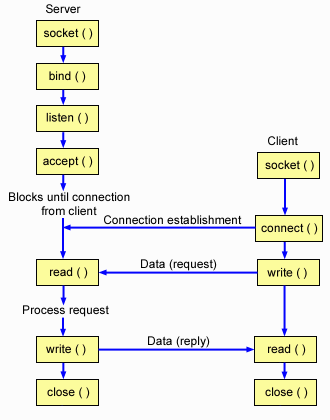These server and client examples illustrate socket APIs written for a connection-oriented protocol such as Transmission Control Protocol (TCP).
The following figure illustrates the client/server relationship of the sockets API for a connection-oriented protocol.

Socket flow of events: Connection-oriented server
The following sequence of the socket calls provide a description of the figure. It also describes the relationship between the server and client application in a connection-oriented design. Each set of flows contain links to usage notes on specific APIs.
- The socket() function returns a socket descriptor representing an endpoint. The statement also identifies that the INET (Internet Protocol) address family with the TCP transport (SOCK_STREAM) is used for this socket.
- The setsockopt() function allows the local address to be reused when the server is restarted before the required wait time expires.
- After the socket descriptor is created, the bind() function gets a unique name for the socket. In this example, the user sets the s_addr to zero, which allows connections to be established from any IPv4 client that specifies port 3005.
- The listen() allows the server to accept incoming client connections. In this example, the backlog is set to 10. This means that the system queues 10 incoming connection requests before the system starts rejecting the incoming requests.
- The server uses the accept() function to accept an incoming connection request. The accept() call blocks indefinitely waiting for the incoming connection to arrive.
- The select() function allows the process to wait for an event to occur and to wake up the process when the event occurs. In this example, the system notifies the process only when data is available to be read. A 30-second timeout is used on this select() call.
- The recv() function receives data from the client application. In this example, the client sends 250 bytes of data. Thus the SO_RCVLOWAT socket option can be used, specifying that recv() does not wake up until all 250 bytes of data have arrived.
- The send() function echoes the data back to the client.
- The close() function closes any open socket descriptors.
Socket flow of events: Connection-oriented client
The Example: A connection-orientated client uses the following sequence of function calls:
- The socket() function returns a socket descriptor representing an endpoint. The statement also identifies that the INET (Internet Protocol) address family with the TCP transport (SOCK_STREAM) is used for this socket.
- In the client example program, if the server string that was passed into the inet_addr() function was not a dotted decimal IP address, then it is assumed to be the host name of the server. In that case, use the gethostbyname() function to retrieve the IP address of the server.
- After the socket descriptor is received, the connect() function is used to establish a connection to the server.
- The send() function sends 250 bytes of data to the server.
- The recv() function waits for the server to echo the 250 bytes of data back. In this example, the server responds with the same 250 bytes that was just sent. In the client example, the 250 bytes of the data might arrive in separate packets, so the recv() function can be used over and over until all 250 bytes have arrived.
- The close() function closes any open socket descriptors.